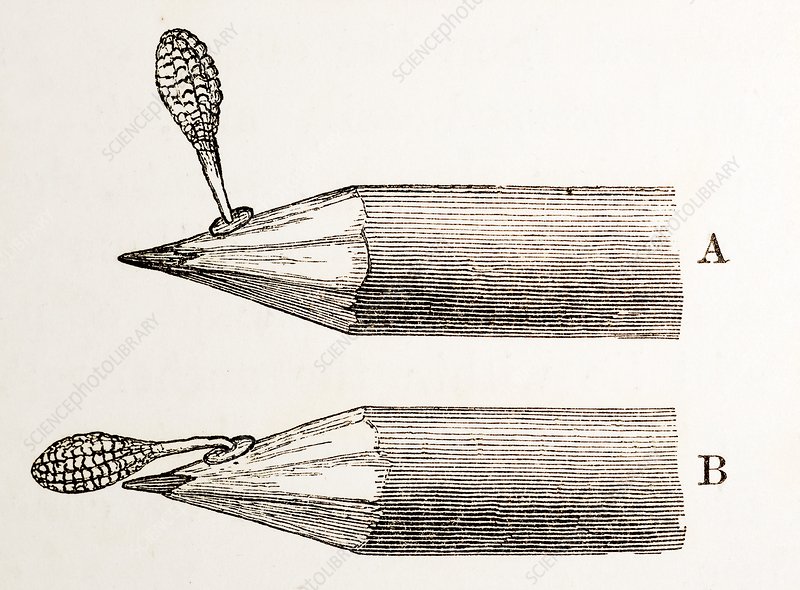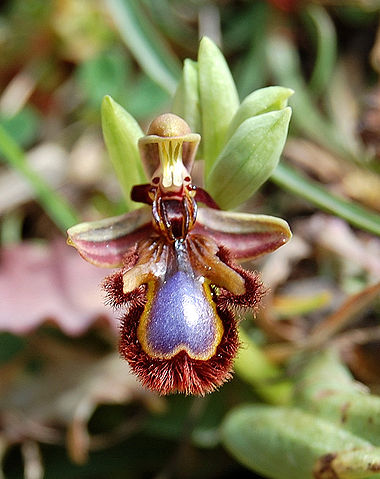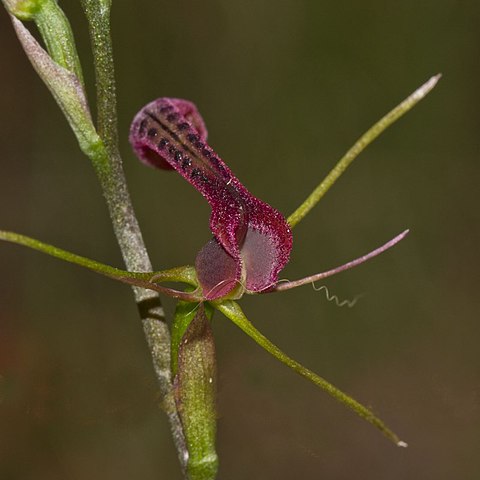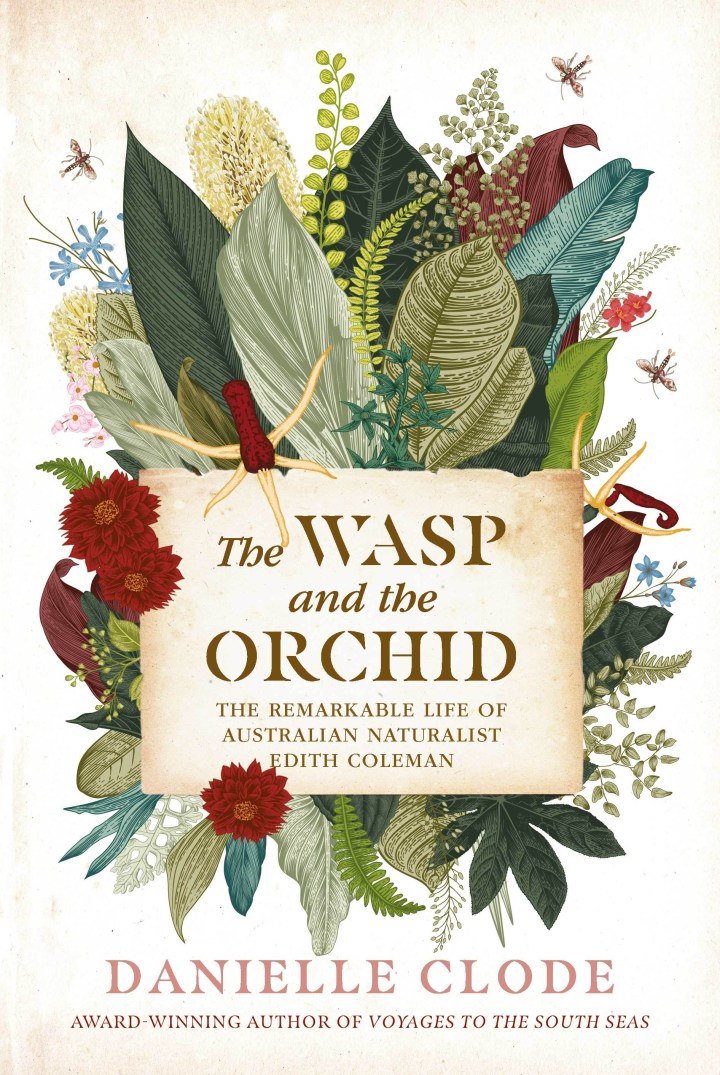
Probably the most "bug-like" orchid flower we've ever seen. Unidentified Bulbophyllum photographed by Chien Lee in Sarawak, Malaysia. The pollinator is still unknown, but if Chien ever happens to be around when it lands on the flower, his camera is always at the ready. Click on the image to access the photo on Chien's Flickr site, where you can see the image at full resolution, a very remarkable photo!
April, 2021

Orchid "Bug Mimics" — The Strange Story of Pouyannian Mimicry

Darwin's "pencil experiment", from Fertilisation of Orchids. When the pollinia of Orchis masculis are removed on the tip of a pencil, the stalk spontaneously bends forward within about 30 seconds.
Orchid flowers baffled Charles Darwin. He spent years puzzling over the incredibly diverse ways in which orchids lure their pollinators to their flowers. In fact, his first major publication after On the Origins of Species, which appeared in 1859, was his account of his long study of orchid flowers, Fertilisation of Orchids: On the Various Contrivances by Which British and Foreign Orchids are Fertilised by Insects, and on the Good Effects of Intercrossing (1862, with later editions to 1882). When he began his serious study of orchid flowers, about 1839, not much was known about the pollination of orchids. Darwin posed questions about the ways in which orchids and their insect pollinators interacted and how, in effect, their life cycles were interdependent, a completely novel way of looking at nature.
Some of the pollination strategies were fairly obvious, such as the flowers where an insect such as a bee or moth probes the flower to obtain nectar, and in the process ends up with the orchid's pollinia stuck to its head or back, strategically positioned (Darwin noticed that the stalk of the pollinia, once attached to the insect, soon bends forward to move it into the best position for fertilization) so that it will be deposited on the stigmatic surface of the next flower the insect visits. But not all orchid flowers produce a nectar "reward". Why do insects or other pollinators visit such apparently "rewardless" flowers?

Ophrys speculum, a terrestrial orchid pollinated by a wasp, Colpa aurea
An answer was finally provided in 1916 by a Frenchman, Maurice-Alexandre Pouyanne (born in Tlemcen, Algeria, November 14, 1867, died after 1939, probably in Algeria), son of a mining engineer and cartographer who worked in Algeria. Maurice-Alexandre pursued a legal career and was recognized as an expert on the indigenous Algerian system of property law and its administration under French rule. He was also a gifted amateur botanist. After he, like Darwin, had accumulated many years of observations on several species of Ophrys, he was able to publish his observations in France with the assistance of the Swiss horticulturalist and botanist Henry Correvon, who was a member of the French national horticultural society.

Ophrys lutea, in different parts of its range and in different varieties, pollinated by various small bees of the genus Andrena
The announcement that Ophrys flowers actually deceived the males of a certain species of wasp into attempted mating, as if the flowers were female wasps, seems to have been treated mostly as a curiosity, but a few other botanists continued the research. Today, the research into the nature of this "sexual deception" has traced the nature of the deception to an array of up to a hundred different chemical compounds that are manufactured in various ways and in various parts of the bodies of the female wasps, functioning as natural attractants or pheromones for the males of the species (it has even been possible to determine which compounds cause an electro-physiological response in the insect's antennae!), and the discovery that these same compounds and in many cases in the same proportions are also manufactured in specific parts of the Ophrys flowers. The microscopic hairs and surface contours of the Ophrys flowers, as well as some aspects of the coloration of the flower, have been shown to facilitate the attempted mating in such as way as to direct the orchid's pollinia to attach to the insect in precisely the right position and orientation so that the next flower will be able to receive the pollinia and thereby set seed.
Jim Endersby, at the University of Sussex, has published an intriguing review under the title "Deceived by orchids: sex, science, fiction and Darwin" (British Journal for the History of Science, June, 2016, pp. 1-25), recounting some of the odd episodes in which Darwin's fascination with orchids intersected with popular culture and a new awareness of the workings of the natural world. In particular, he provides a thorough account of Pouyanne's discovery and the subsequent verification and extension of his ideas by two other botanists, Col. Masters John Godfery in England, and Edith Coleman in Australia.

Pouyanne's drawings from his first publication in 1916. In figures 3-6, the insect backs into the flower of Ophrys lutea, and flies away with the pollinia attached to his abdomen. In figures 7-10, Ophrys speculum, the wasp enters the flower head-first, and comes away with the pollinia attached to his head.
Pouyanne announced his findings in 1916 (through the agency of Henry Correvon, mentioned above: Maurice-Alexandre Pouyanne and Henry Correvon, 1916, "Un curieux cas de mimétisme chez les Ophrydées", Journal de la Société nationale d'horticulture de France 17:29-31, 41-47), first mentioned in English in 1920 in Orchid Review (but the editor, Robert Allen Rolfe, consistently misspelled the name as "Pouzanne"). Among those who took notice of Pouyanne's discovery was Col. Masters John Godfery, who corresponded with Pouyanne and was able to verify and extend his observations to other Ophrys species. A few years later, Edith Coleman, a school-teacher in Melbourne, Australia and member of the Field Naturalists' Club of Victoria, published an account of the pollination of the Australian terrestrial orchid Cryptostylis leptochila ("Pollination of the orchid Cryptostylis leptochila", Victorian Naturalist (1927) 44:20-22 and Plate XXIII, followed by additional details the next year,loc. cit. (1928) 44:333-340). In this orchid, the pollinator, an ichneumon wasp (a predatory wasp, which in theory should not be interested in nectar, and besides, this flower seems not to produce any nectar at all), backs into the flower, an oddity that Mrs. Coleman's daughter first noticed and brought to her mother's attention. Mrs. Coleman regarded the first paper as "preliminary", and in the second paper, based on observations made in the next year, she credited Pouyanne and Godfery with the solution to the long-standing problem of the apparent "attacks" by bees upon the flowers of some Ophrys species. Coleman's observations, noting the anatomical features of the orchid and the way they exactly matched the mechanical requirements for mating by the male wasp, really clinched the story, while at the same time establishing that sexual deception in orchids was not limited to the famous "Bee orchids" of Europe and the Mediterranian region.

Cryptostylis leptochila, the "small tongue orchid", an endemic terrestrial orchid from Australia.
All three observers were able to use simple experiments to identify the nature of the attraction. Pouyanne tried covering the flowers with newspaper; the male wasps were still attracted. Separating the lip from the rest of the flower showed that it was the lip that was the source of the attraction. It was possible to know which flowers had been cross-pollinated by observing that the flower's own pollinia were still in place, while additional pollinia were present on the stigmatic surface. Individual insects were observed with pollinia either on their heads or on their abdomens. It was even possible for Mrs. Coleman to snip off flowers with the wasp still attached (the males of this particular ichneumon wasp have specialized clasping appendages used during mating) and drop it into a "killing bottle" containing formaldehyde or cyanide, thus allowing later photography to document how the insect and the flower interacted.

Edith Coleman (1874-1951) was a thoroughly remarkable woman, recipient of the Australian Natural History Medallion, and one of Australia's foremost orchid experts. A biography by Danielle Clode has recently been published, The Wasp and the Orchid: The Remarkable Life of Australian Naturalis Edith Coleman (Picador Australia, 2018).
Mrs. Coleman knew she was on to something: "It is, I think, safe to assume that, as the orchid C. leptochila is visited by male wasps only, and as these are seeking neither nectar nor edible tissue, they are answering to an irresistible sex-instinct, and the reason for the unusual partnerships thus becomes less incredible than it at first appeared. We know that pollination is the sole object in the structure of an orchid, and we are familiar with the many strange devices adopted by flowers to achieve this end; but in the present instance the perfected plan of the flower to obtain the benefit of cross-pollination unfolds a scheme unrivalled, surely, in the history of entomophilous flowers."
Biologists in the 19th and 20th Centuries were intrigued by the idea of mimicry, and eventually realized that there were a number of distinct strategies involved. A species might look like another, not closely related species that tastes bad, in order to escape being eaten. Or a species might look like something else entirely, in order to escape its predators. Or, a predator might look like something else, in order to escape detection by its prey. It became apparent that there were many different types of mimicry in the natural world, and the biologist now has to navigate an ever-growing list of terminology (see our list of some of the the main types, below).
Author Danielle Clode, biographer of Edith Coleman, remarked on the role of the Field Naturalists Club in the transformation of Edith from a housewife (with scarcely three years of experience as a teacher) into an exceptional naturalist. That rang a bell! It's the same story of SCOS and the other orchid clubs in Southern California, where any number of people who lacked formal training in botany or natural science felt encouraged to expand their knowledge and skills into such areas as orchid breeding, genetics, taxonomy, photography, writing, etc. The Field Naturalists Club was founded in 1880, and by the time Edith came along, around 1920, the club had a diverse and inclusive membership — "men and women of all classes, and juniors, too, were encouraged to join, irrespective of their level of learning or expertise, whether or not they were interested in actual research" — and had already undertaken many activities and projects, including successful campaigns for the establishment of national parks in order to preserve special natural areas. This is still the function of local clubs based on shared interests.
So it is, that the "sexual deception" of orchids is now called "Pouyannian Mimicry", in honor of the "amateur" botanist who discovered it, Maurice-Alexandre Pouyanne. The history of biology is full of brilliant minds who patiently observed the natural world, without specialized training, academic positions, grants from the National Science Foundation or the National Institutes of Health — whose insights have changed the course of science. They have been called "amateurs" by card-carrying scientists, but we have often wondered if that label is applied out of jealousy. Today, they would probably be called "citizen scientists", which we find equally pejorative. The long, patient application of the logical mind to the nature we find around us, including experimentation, is that not science at its most fundamental?
How widespread is Pouyannian mimicry in orchids? One review says there are at least 18-20 genera involved, but we haven't yet found a comprehensive list. The ones we know about so far include: Ophrys, about 300 species, nearly all of which have a lip that resembles the female of some sort of wasp or bee; Serapias?; Chiloglottis, more than 30 species pollinated by wasps of the genus Neozeleboria; additional Australian genera Paracaleana, Spiculaea, and Caladenia, pollinated by various thynnine wasps; Cryptostylis leptochila (Australian tongue orchid), resembles the ichneumon wasp Lissopimpla semipunctata; Mormolyca ringens (Maxillaria tribe) attracts drones of at least two species of bees; Drakaea glyptodont, an endangered Australian species, pollinated by yet another wasp, also other species of Drakaea; Lepanthes, there is at least one report involving attempted mating by male fungus gnats; Trigonidium obtusum, in the Maxilliaria tribe. In addition,there have been reports of similar pollination mechanisms in Trichoceros, Telipogon, and Tolumnia, but apparently not everyone is convinced about these three genera. There are many other orchids with peculiar features of the lip that make us wonder about the identity of the pollinator and why it visits the flower.
There are also other variations of mimicry that attract insects interested in mating, but don't actually mimic the females. Instead, they may mimic the favored location for mating or of depositing the eggs — such as the gills of a mushroom, or the appearance and smell of rotting meat — or they might mimic a completely unrelated flower where a particular insect normally seeks a mate, resulting in occasional pollination of the orchid. The trickery seems endless.
Where does that leave Chien Lee's Bulbophyllum with the amazingly bug-like flowers? As with all Pouyannian mimics, we cannot really know, until someone observes the pollinator and its behavior. Chien told us he suspects the long-lasting flowers of many orchids in the dark forests of Malaysia are an adaptation for pollinators that visit the flowers only infrequently. The orchids themselves are widely scattered. That means catching the pollinator in action will be difficult. Some have suggested that this new Bulbophyllum may belong in the section Hirtula, whose roughly 12 species have somewhat similar bug-like flowers. A recent revision appeared in the journal Taiwania 62(1):1-23 (2016), with some intriguing pictures. Those Bornean forests are disappearing at an alarming rate, replaced in many areas by oil palm plantations. The last areas to remain "undeveloped" will likely be those forests growing on extremely rugged karst, where commercial agriculture is not possible. The wonders of nature unique to places like Borneo are very much at risk.
Short List of Some Major Forms of Mimicry
- Batesian — named after English explorer and naturalist Henry Walter Bates, who described it in 1861. Prey species who are otherwise tasty or desirable strongly resemble other prey species that taste bad, and thus deceive predators into avoiding them. Example: Bates observed Amazonian butterflies, belonging to different insect families, that had very similar markings. How he knew or suspected that one species was in fact distasteful and its mimic not (i.e., which was the "mimic" and which was the "model"), we haven't yet learned. Later experimentation (probably using "naive" birds to see how they react upon eating either species) has revealed many cases where this is exactly what is going on.
- Müllerian — named after German naturalist Fritz Müller, who described it in 1878. Different prey species that taste bad or are otherwise best avoided, share a common appearance and thus, collectively, warn away potential predators who have had a bad experience with any one of them. Example: Monarch and Viceroy butterflies look very similar, and, it turns out, are equally unpalatable to birds. You may have learned differently; this used to be a textbook example of Batesian mimicry, from the belief that Viceroy butterflies taste good! We have not encountered anyone who has actually tasted either of them.
- Emsleyan — named after M. G. Emsley, and also suggested or described earlier by Robert Mertens, M. K. Hecht, and D. Marien. The example of the very poisonous coral snake and its Batesian mimic the harmless Mexican milk snake, which has the same bold red, yellow, and black banding but in a different order, is well known, but Emsley wondered how an animal could learn to avoid the poisonous coral snake, when its first encounter was likely to be fatal. Emsley suggested there might be less fatal species that would give a predator a bad scare but not actually kill them, so that the extremely lethal coral snake would be a more poisonous mimic of a less lethal model species. However, it has since been learned that some birds, such as the Turquoise-browed Motmot of Central America, have an instinctive avoidance of snakes with red and yellow rings, even in hand-reared birds. Also, in baboons, it seems individual can learn from the bad experiences of other members of their group, and thus learn to avoid a distinctive poisonous snake without having been bitten by it.
- Wasmannian — a very odd one! In ant colonies, a number of spiders and insects mimic ants, and may avoid predators that way, or, turning the concept on its head, may disguise themselves so well that the ants can't tell the difference, and the mimic preys on the ants themselves. There are jumping spiders that look exactly like red ants.
- Vavilovian — named after Nikolai Vavilov, a Russian plant geneticist. Humans, it turns out, have been pulling weeds from their crops since at least Neolithic times. This practice has resulted in the unintentional selection of "weeds" that more and more resemble actual human crops. One prominent example is rye, believed originally to have been a weed in wheat and barley crops. With continued selection, the rye plants that looked most like wheat survived, including those that produced the largest and most numerous seeds, and with a compatible life cycle (becoming an annual, while wild rye is a perennial plant). Oats seems to have undergone a similar transformation, from a wild grass to a significant crop.
- Dodsonian — named after Calaway H. Dodson, a name many orchidists will recognize. The prime example is Epidendrum ibaguense, a common roadside terrestrial orchid, often with red and yellow flowers (it comes in other colors as well). The flowers strongly resemble those of a common milkweed found in the same area and often seen in Long Beach as a garden flower, Asclepias curassavica, as well as some color forms of Lantana camara, all with a similar red and yellow pattern. All of these are pollinated by monarch butterflies and perhaps also by hummingbirds. However, the Epidendrum has little or no nectar, so it is a "rewardless" mimic of the other two. Some Oncidium flowers that don't provide nectar closely resemble the flowers of unrelated species in the family Malpighiaceae, a fact that became important in recent revisions of Oncidium, since it became apparent that this kind of mimicry was exhibited by a number of species in the Oncidium tribe that were not closely related, and thus, grouping the species based mainly on floral characteristics in the taxonomy was deemed inappropriate.
- Pouyannian — named after Maurice-Alexandre Pouyanne, as described in the main article, above. The flower mimics a female insect (often a bee or wasp) so convincingly that male insects are induced to attempt mating with the flower, resulting in the orchid's pollinia becoming attached to the insect, and thus completing cross-pollination when the next flower is visited.
There are many more types of mimicry: insects and spiders that look like various parts of plants, plant parts that look like bugs, preying mantises that look like flowers, "leaf butterflies", "stick insects", and insects, fish and other animals with "eye spots" or false antennae on the wrong end of the animal, all evidently deceiving other animals in some way.